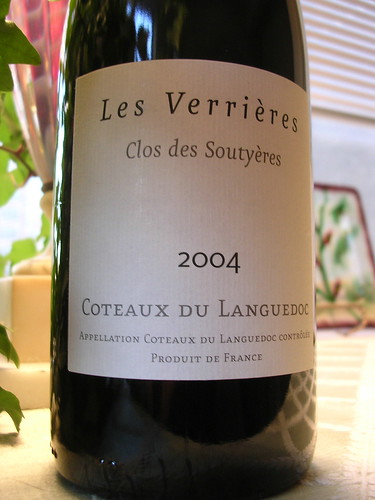Les Verrières - Clos des Soutyères, Coteaux du Languedoc 2004 (PLCB No. 20202)

The Clos des Soutyères from Les Verrières hails from within the Languedoc-Roussillon region of Southern France, a region known for producing wines at the value end of the spectrum. It is a blend of Syrah, Grenache and Carignane (the varietal primarily responsible for this wine’s aggressive tannins and 14% alcohol content). This is a bold red. You’ll taste a quartet of darks—dark cherries, dark plum, dark chocolate and dark coffee. The finish is long; the chocolate seems to hang on forever. But the tannins have even greater stamina, tingling your gums long after the chocolate has disappeared.
In addition to how it tastes, though, there are two other important reasons you should try this wine. First, it’s a rare opportunity to get a highly rated wine at a very reasonable price. Most wine drinkers, including me, spend a lot of time tracking down great values. And there are some gems out there to be found, even if you do have to sift through a lot of ore sometimes to find them. This is one of those gems.
This wine from Les Verrières is not only reasonably priced at $22.99, but it is also highly rated. In August 2006, Wine Spectator rated this wine a 91. To give you some perspective on what a good deal this is, the 2001 Silver Oak, Napa Valley—a highly coveted and insanely popular cult Cab from California—is rated an 89 and the PLCB charges $99.99.
Some people dismiss wine scores for being subjective and as being nothing more than a marketing tool. Back in August, the New York Times took aim at 100-point wine rating systems because of how wine marketers have been exploiting them. For example, marketers will often trumpet a 90 but ignore an 89, implying that the scores reflect an objectivity and a precision that even respected wine critics will readily admit (and most intelligent consumers already know) just isn’t possible. Some wine merchants have even been accused of inventing high scores to push their wines, affecting the credibility of wine scoring in general.
That being said, a score can still be a useful guide if it comes from a reliable source such as Wine Spectator (Robert Parker’s Wine Advocate and Stephen Tanzer from Food and Wine Magazine are also in that category). And at $22.99, this is great opportunity to experience a 91 from Wine Spectator and incorporate that experience into your wine vocabulary.
The second reason you should try this wine is because it comes from a very limited production. The reason this is important, at least for PA wine consumers, is because of what it may represent—progress.
Pennsylvania’s wine distribution system has taken its lumps over the years. It has been called draconian and has often been criticized as being antagonistic to wine consumers in terms of price and selection. PLCB Chairman Jonathan Newman has done a lot over the past few years to change that. You still may not be able to buy wine at your local grocery store or escape the Johnstown Flood Tax, but things have gotten a whole lot better. The PLCB is now leveraging its buying power as the largest wine purchaser in the country to get some great deals, some of which it offers as Chairman’s Selections. The PLCB also is now offering more high-end wines, although its buying power does not always have the same muscle at this end of the spectrum (for example, the PLCB charges $135 for the 2003 Chateau Ducru-Beaucaillou, a widely-available Second Growth Bordeaux, but it lists elsewhere for $125).
But the one area the PLCB does not focus on is offering wine that is produced in small quantities, which are often some of the most sought-after wines in the world. You can’t blame the PLCB for not pursuing small productions; even in states that have privately run wine distribution systems, a wine merchant can have a hard time landing these desirables. Plus, buying small productions doesn’t seem to fit with the PLCB’s buying model. If you’re buying wine for the whole state (even just the specialty stores), it doesn’t make sense to buy wine produced in quantities so small that you couldn’t offer it in all of your stores. In addition, wine makers that have small productions probably aren’t seduced by the PLCB’s buying power. Even if they had enough product for the PLCB, it’s unlikely that they’d be interested in cutting any sort of deal given that small productions are usually in very high demand, especially if their wine is highly rated.
That’s what makes the Clos des Soutyères such an interesting find here in PA. Les Verrières made only 1,000 cases of this wine, which is a very small production. The PLCB not only managed to capture 403 of the 1,000 cases made, but it was able to get them at a discount (it was quoted at $30)—an amazing coup for a wine rated 91 by Wine Spectator. It is possible that the PLCB just got lucky—maybe it inked the deal with Les Verrières prior to August 2006, something Les Verrières may not have been willing to do had the Wine Spectator rating been published sooner. But even if that is true, at a minimum it shows that the PLCB recognizes the value in opening dialogues with small producers and (hopefully) building lasting relationships with them.
It is not often that you’re able to find a highly rated wine produced in small quantities at a great price. So, you should take advantage of this opportunity while you can. The Les Verrières - Clos des Soutyères (PLCB No. 20202) is available at the PLCB’s Premium Collection Stores.












No comments:
Post a Comment